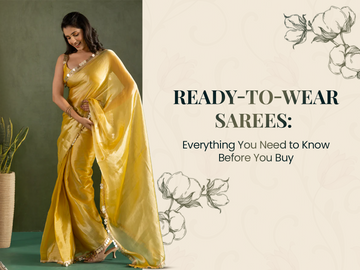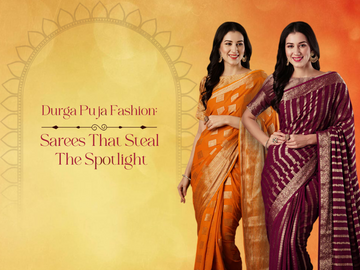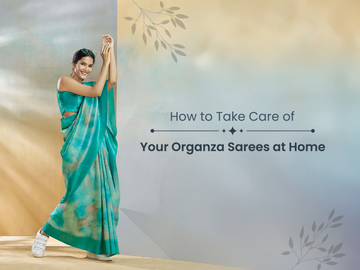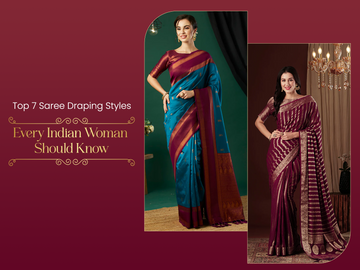The Modern Saree: A Revolution in Draping
The ready-to-wear saree, also called a pre-draped or 1-minute saree, is a modern reinterpretation of one of India’s most iconic garments. Unlike the traditional saree, which requires skillful draping, this version comes pre-stitched with fixed pleats and a pallu, making it as easy to slip on as a skirt or dress. It delivers all the grace of a saree without the time-consuming hassle.
Born out of the need for convenience, the ready-to-wear saree solves a long-standing challenge: the struggle of folding pleats, adjusting the pallu, and pinning everything in place. This modern evolution not only makes the saree more accessible but also positions it as a practical choice for working women, beginners, and anyone who wants elegance on the go.
Although designers and brands frame it as a “revolution,” the idea itself has been around for decades, particularly in theater and performing arts, where fast outfit changes were essential. The difference today lies in innovation—features like stitched-in pockets, adjustable waistbands, and lightweight fabrics have pushed the ready-to-wear saree into mainstream fashion.
The Convenience Imperative: Unpacking the Advantages
The biggest selling point of the ready-to-wear saree is its sheer convenience. It combines style with practicality, making it a favorite for fast-paced lifestyles.
- Quick and effortless draping: A ready-to-wear saree can be worn in under a minute—slip, hook, drape, and you’re ready.
- Beginner-friendly: Perfect for those intimidated by traditional draping, guaranteeing a polished look every single time.
- All-day comfort: Pre-stitched for stability, many designs are made with lightweight breathable fabrics that move easily with the body.
- Low maintenance: These sarees often use fabrics that require minimal care compared to heavy silks or delicate weaves.
By removing the barriers of time and complexity, the ready-to-wear saree is also introducing the garment to a younger generation, keeping the tradition alive in a contemporary avatar.
The Art of Compromise: Disadvantages and Nuanced Considerations
While convenient, ready-to-wear sarees do come with trade-offs. Buyers should weigh the following before investing:
- Limited styling flexibility: The pre-stitched form restricts draping styles, unlike a traditional saree with endless experimentation options.
- Fit challenges: Standard sizing may not flatter all body types, leading to issues like loose waists or awkward pleats.
- Authenticity concerns: Purists argue that the essence of saree-wearing lies in its draping art, which gets diluted.
- Higher costs: Pre-stitching often makes these garments more expensive—sometimes 20–30% more than unstitched sarees of similar fabric.
Ultimately, it boils down to a choice between practical convenience and cultural authenticity.
Ready-to-Wear vs. Traditional Sarees
| Attribute | Ready-to-Wear Saree | Traditional Saree |
|---|---|---|
| Draping Time | Under a minute | Takes practice, can be time consuming |
| Ease of Wearing | Effortless, beginner-friendly | Requires skill and precision |
| Draping Styles | Fixed style only | Unlimited variations |
| Fit | Standard/pre-stitched | Customizable with each drape |
| Cost | Slightly higher due to stitching | Can be more affordable |
| Cultural Value | Modern reinterpretation | Deep traditional heritage |
A Style for Every Story: Fabrics and Silhouettes
The diversity of ready-to-wear sarees is one reason they’ve grown in popularity. Designers use the pre-stitched structure to create styles that are both experimental and accessible.
Popular Silhouettes
- Pre-pleated sarees: Closest to traditional draping, with stitched pleats.
- Gown-style sarees: A fusion of gown and saree, perfect for cocktail events.
- Dhoti or pant-style sarees: Contemporary, bold alternatives replacing the petticoat with pants or dhotis.
- Skirt-style sarees: Flared or straight skirts with stitched pallu, blending lehenga-like volume with saree elegance.
Picking the Right Fabric
- Everyday wear: Cotton, mulmul, linen for comfort.
- Festive occasions: Chiffon, georgette, and satin for fluid elegance.
- Weddings: Luxurious silks like Banarasi, Katan silk, or tissue silk with traditional embellishments.
Best Styles and Fabrics by Occasion
| Occasion | Suggested Styles | Fabrics |
|---|---|---|
| Casual/Office | Pre-pleated, dhoti | Cotton, Linen |
| Cocktail Parties | Gown-style, slit sarees | Georgette, Satin, Sequins |
| Festivals | Dhoti-style, pre-pleated | Chiffon, Georgette |
| Weddings | Skirt-style, gown-style | Silk, Organza |
| Brunch/Daytime | Pre-pleated, skirt-style | Chiffon, Organza |
The Smart Buyer’s Checklist
Before buying a ready-to-wear saree, it’s essential to check a few things:
- Take accurate waist and height measurements for a perfect fit.
- Choose breathable fabrics for comfort.
- Invest in a well-fitted blouse to complete the look.
- Consider using a saree shaper skirt for a flattering silhouette.
- Explore converting your old sarees into ready-to-wear versions—a sustainable and personalized option.
The Market and Its Momentum
The ready-to-wear saree market is booming, powered by changing lifestyles, fast fashion trends, and digital influence. From budget-friendly Etsy finds to high-end luxury pre-draped creations by designers like Anita Dongre, the spectrum is wide.
Key Innovators
- Aseem Shakti: Introduced India’s first pocket saree.
- Anita Dongre: Luxe pre-stitched sarees with rich fabrics and intricate detailing.
- Flourious: A fashion house that blends heritage craftsmanship with modern convenience. From weaving to bridal and ready-to-wear collections, everything is crafted under one roof.
Consumer Trends
- Positive feedback: Comfortable, stylish, and beginner-friendly.
- Common complaints: Fit issues, limited variety, and occasional high prices.
This dual nature—mass-market affordability on one side and luxury indulgence on the other—ensures broad appeal.
Is a Ready-to-Wear Saree for You?
The ready-to-wear saree isn’t just a trend; it’s a smart reinvention of tradition. It’s perfect for:
- Busy professionals who need elegance in minutes.
- Beginners intimidated by traditional draping.
- Fashion-forward women seeking fresh, modern silhouettes.
At the same time, it gives traditional sarees a new lease on life through sustainable transformations. By balancing heritage with modern practicality, ready-to-wear sarees ensure that this timeless garment remains relevant for generations to come.





